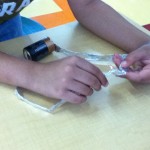Make a Flashlight

Author(s): Lisa Tibbetts
Subject: Physics
Grade Level(s): Grade 4
Big Idea(s): Students will discover how to connect the materials to make a closed circuit that will make a light bulb light.
What you need: light bulb
D-cell battery
aluminum foil
Student Office (dividers to work in your own space)
Science Notebook
Sentence Frames
Setting: Classroom or lab setting with students grouped in pairs/partners.
Time Needed: The lesson will take aprox. 45 min to 1 hour.
Summary:
This is a hands-on discovery lesson for students to make a light bulb light by making a circuit out of a battery, aluminum foil and a light bulb.
Learning Goals / Objectives:
4 PS 1.a. Students know how to design and build simple series and parallel circuts by using components such as wires, batteries, and light bulbs.
Background
Students need to understand that energy can flow through a wire conductor and produce heat, light or energy.
Setup:
Students are grouped in pairs with a student office to keep their discovery ideas concealed.
Each pair is given a baggie with a battery, tin foil, and a light bulb.
Anticipatory Set:
Ask the students to think about “How you can make a flashlight light up?” Allow the students to talk with thier partner and then share their ideas with the class.
Instructions / Activities:
1. Teacher instructs the students that they are going to discover how to make a light bulb light up.
2. Each pair is given a baggie with materials: tin foil, a battery, and a light bulb.
3. The students work together to figure out how to connect all three pieces to make the light bulb light up.
4. Give the students 10-15 minutes to test their ideas.
5. If they figure out how to make the light bulb light, they can use the sentence frames to write about thier experience.
6. If some pairs are struggling, other pairs can become helpers.
7. Students will use the sentence frames to write about their circuit.
8. Have the students draw and label a picture of their circuit.
8. Have students share their thoughts with their partner and/or other pairs in the classroom.
Assessment:
Students will be assessed on their science notebook sentence frame thoughts and ideas as well as their labeled diagram of a circuit.
Wrap-up / Closure:
Have the students share their thoughts and ideas from their science notebook. The teacher can connect their learning to a shared diagram on the board showing how a current flows from the battery throught the wires and the lightbulb to make the lightbulb light.

